Leadership Styles in International Business: Case Studies in China
VerifiedAdded on 2020/03/01
|10
|2353
|44
Report
AI Summary
This report delves into the realm of international business, focusing on the critical role of leadership styles within Chinese companies, specifically PetroChina and Huawei. It begins by outlining various leadership approaches, including autocratic, democratic, transformational, and transactional styles, and their impact on organizational culture and performance. The report then presents case studies of PetroChina, which primarily employs an autocratic leadership style, and Huawei, which favors a democratic approach, analyzing how these styles align with their respective business operations and strategic goals. Furthermore, the report explores alternative leadership styles that can address contemporary management challenges, such as developing relevant skills, motivating employees, and managing change. For PetroChina, the transformational leadership style is suggested, while for Huawei, the transactional leadership style is proposed. The report concludes by emphasizing the significance of adapting leadership styles to foster a healthy work environment and enhance overall business outcomes within the dynamic context of international business in China.
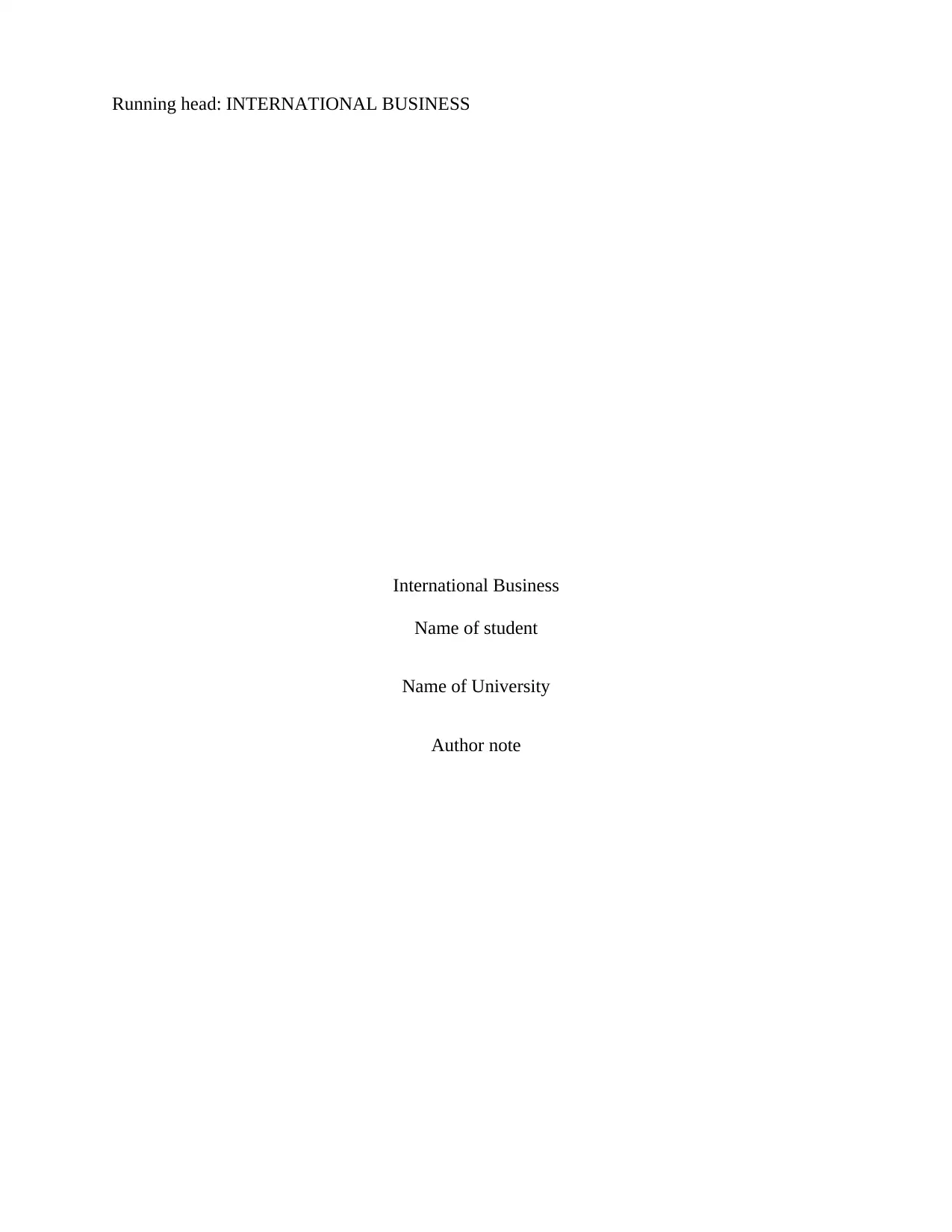
Running head: INTERNATIONAL BUSINESS
International Business
Name of student
Name of University
Author note
International Business
Name of student
Name of University
Author note
Paraphrase This Document
Need a fresh take? Get an instant paraphrase of this document with our AI Paraphraser
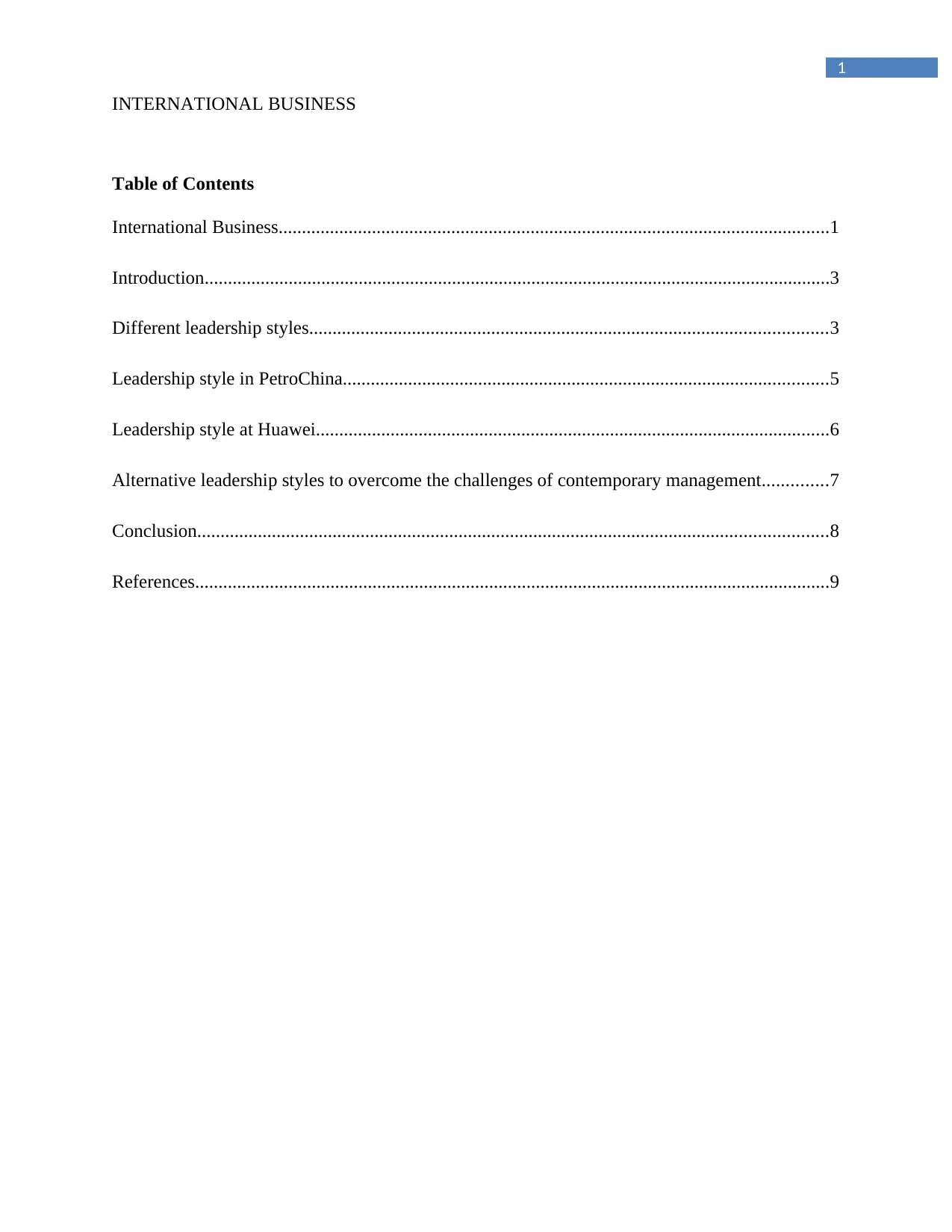
1
INTERNATIONAL BUSINESS
Table of Contents
International Business......................................................................................................................1
Introduction......................................................................................................................................3
Different leadership styles...............................................................................................................3
Leadership style in PetroChina........................................................................................................5
Leadership style at Huawei..............................................................................................................6
Alternative leadership styles to overcome the challenges of contemporary management..............7
Conclusion.......................................................................................................................................8
References........................................................................................................................................9
INTERNATIONAL BUSINESS
Table of Contents
International Business......................................................................................................................1
Introduction......................................................................................................................................3
Different leadership styles...............................................................................................................3
Leadership style in PetroChina........................................................................................................5
Leadership style at Huawei..............................................................................................................6
Alternative leadership styles to overcome the challenges of contemporary management..............7
Conclusion.......................................................................................................................................8
References........................................................................................................................................9
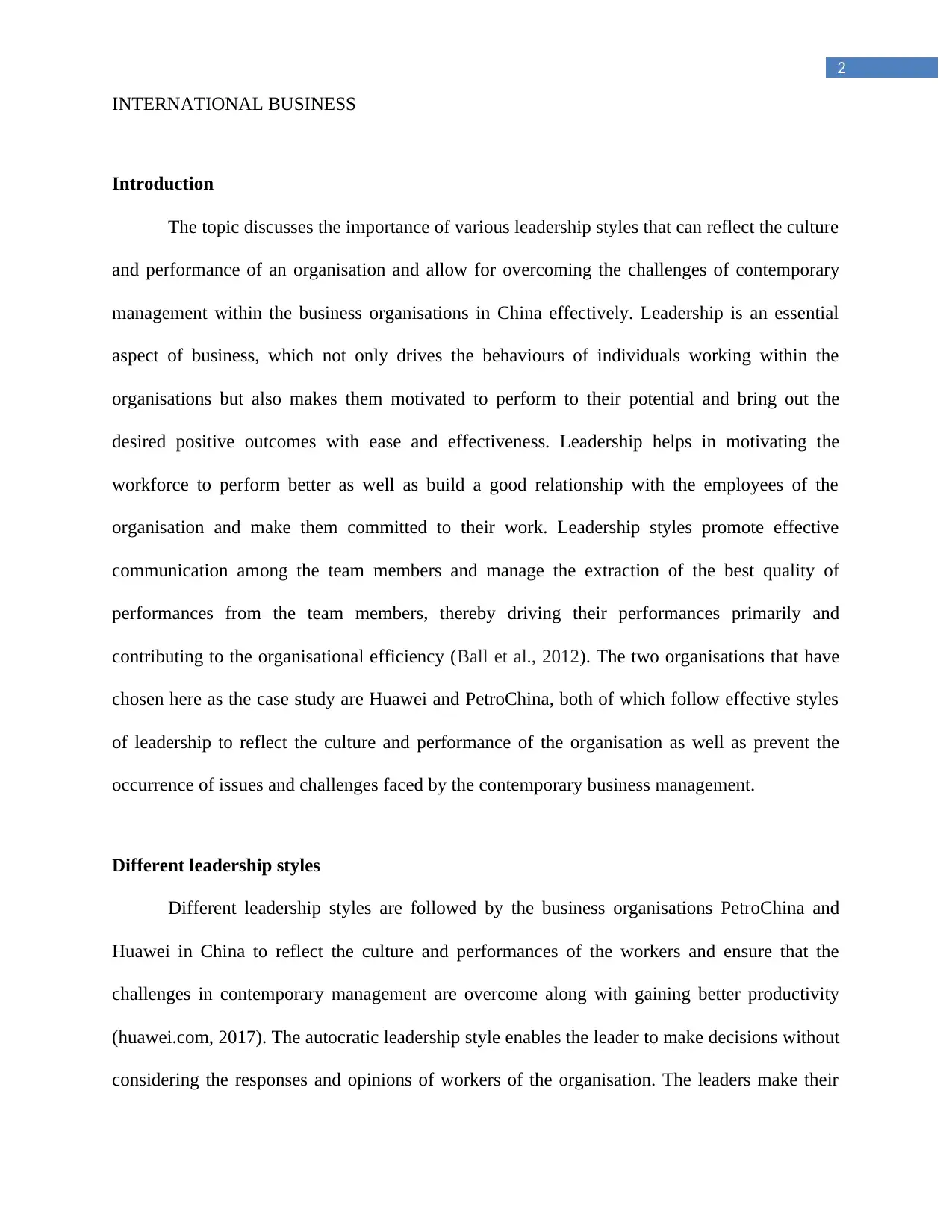
2
INTERNATIONAL BUSINESS
Introduction
The topic discusses the importance of various leadership styles that can reflect the culture
and performance of an organisation and allow for overcoming the challenges of contemporary
management within the business organisations in China effectively. Leadership is an essential
aspect of business, which not only drives the behaviours of individuals working within the
organisations but also makes them motivated to perform to their potential and bring out the
desired positive outcomes with ease and effectiveness. Leadership helps in motivating the
workforce to perform better as well as build a good relationship with the employees of the
organisation and make them committed to their work. Leadership styles promote effective
communication among the team members and manage the extraction of the best quality of
performances from the team members, thereby driving their performances primarily and
contributing to the organisational efficiency (Ball et al., 2012). The two organisations that have
chosen here as the case study are Huawei and PetroChina, both of which follow effective styles
of leadership to reflect the culture and performance of the organisation as well as prevent the
occurrence of issues and challenges faced by the contemporary business management.
Different leadership styles
Different leadership styles are followed by the business organisations PetroChina and
Huawei in China to reflect the culture and performances of the workers and ensure that the
challenges in contemporary management are overcome along with gaining better productivity
(huawei.com, 2017). The autocratic leadership style enables the leader to make decisions without
considering the responses and opinions of workers of the organisation. The leaders make their
INTERNATIONAL BUSINESS
Introduction
The topic discusses the importance of various leadership styles that can reflect the culture
and performance of an organisation and allow for overcoming the challenges of contemporary
management within the business organisations in China effectively. Leadership is an essential
aspect of business, which not only drives the behaviours of individuals working within the
organisations but also makes them motivated to perform to their potential and bring out the
desired positive outcomes with ease and effectiveness. Leadership helps in motivating the
workforce to perform better as well as build a good relationship with the employees of the
organisation and make them committed to their work. Leadership styles promote effective
communication among the team members and manage the extraction of the best quality of
performances from the team members, thereby driving their performances primarily and
contributing to the organisational efficiency (Ball et al., 2012). The two organisations that have
chosen here as the case study are Huawei and PetroChina, both of which follow effective styles
of leadership to reflect the culture and performance of the organisation as well as prevent the
occurrence of issues and challenges faced by the contemporary business management.
Different leadership styles
Different leadership styles are followed by the business organisations PetroChina and
Huawei in China to reflect the culture and performances of the workers and ensure that the
challenges in contemporary management are overcome along with gaining better productivity
(huawei.com, 2017). The autocratic leadership style enables the leader to make decisions without
considering the responses and opinions of workers of the organisation. The leaders make their
⊘ This is a preview!⊘
Do you want full access?
Subscribe today to unlock all pages.

Trusted by 1+ million students worldwide
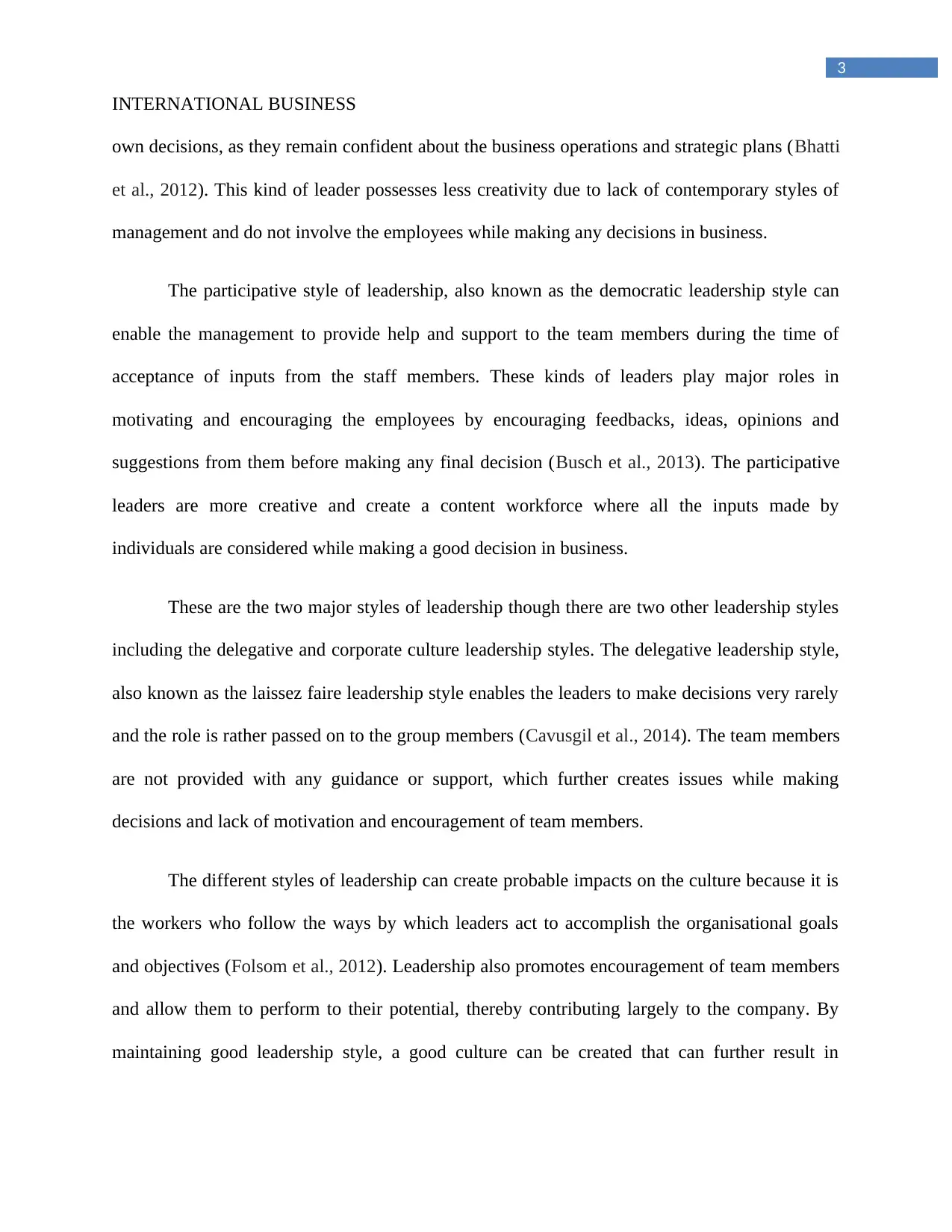
3
INTERNATIONAL BUSINESS
own decisions, as they remain confident about the business operations and strategic plans (Bhatti
et al., 2012). This kind of leader possesses less creativity due to lack of contemporary styles of
management and do not involve the employees while making any decisions in business.
The participative style of leadership, also known as the democratic leadership style can
enable the management to provide help and support to the team members during the time of
acceptance of inputs from the staff members. These kinds of leaders play major roles in
motivating and encouraging the employees by encouraging feedbacks, ideas, opinions and
suggestions from them before making any final decision (Busch et al., 2013). The participative
leaders are more creative and create a content workforce where all the inputs made by
individuals are considered while making a good decision in business.
These are the two major styles of leadership though there are two other leadership styles
including the delegative and corporate culture leadership styles. The delegative leadership style,
also known as the laissez faire leadership style enables the leaders to make decisions very rarely
and the role is rather passed on to the group members (Cavusgil et al., 2014). The team members
are not provided with any guidance or support, which further creates issues while making
decisions and lack of motivation and encouragement of team members.
The different styles of leadership can create probable impacts on the culture because it is
the workers who follow the ways by which leaders act to accomplish the organisational goals
and objectives (Folsom et al., 2012). Leadership also promotes encouragement of team members
and allow them to perform to their potential, thereby contributing largely to the company. By
maintaining good leadership style, a good culture can be created that can further result in
INTERNATIONAL BUSINESS
own decisions, as they remain confident about the business operations and strategic plans (Bhatti
et al., 2012). This kind of leader possesses less creativity due to lack of contemporary styles of
management and do not involve the employees while making any decisions in business.
The participative style of leadership, also known as the democratic leadership style can
enable the management to provide help and support to the team members during the time of
acceptance of inputs from the staff members. These kinds of leaders play major roles in
motivating and encouraging the employees by encouraging feedbacks, ideas, opinions and
suggestions from them before making any final decision (Busch et al., 2013). The participative
leaders are more creative and create a content workforce where all the inputs made by
individuals are considered while making a good decision in business.
These are the two major styles of leadership though there are two other leadership styles
including the delegative and corporate culture leadership styles. The delegative leadership style,
also known as the laissez faire leadership style enables the leaders to make decisions very rarely
and the role is rather passed on to the group members (Cavusgil et al., 2014). The team members
are not provided with any guidance or support, which further creates issues while making
decisions and lack of motivation and encouragement of team members.
The different styles of leadership can create probable impacts on the culture because it is
the workers who follow the ways by which leaders act to accomplish the organisational goals
and objectives (Folsom et al., 2012). Leadership also promotes encouragement of team members
and allow them to perform to their potential, thereby contributing largely to the company. By
maintaining good leadership style, a good culture can be created that can further result in
Paraphrase This Document
Need a fresh take? Get an instant paraphrase of this document with our AI Paraphraser
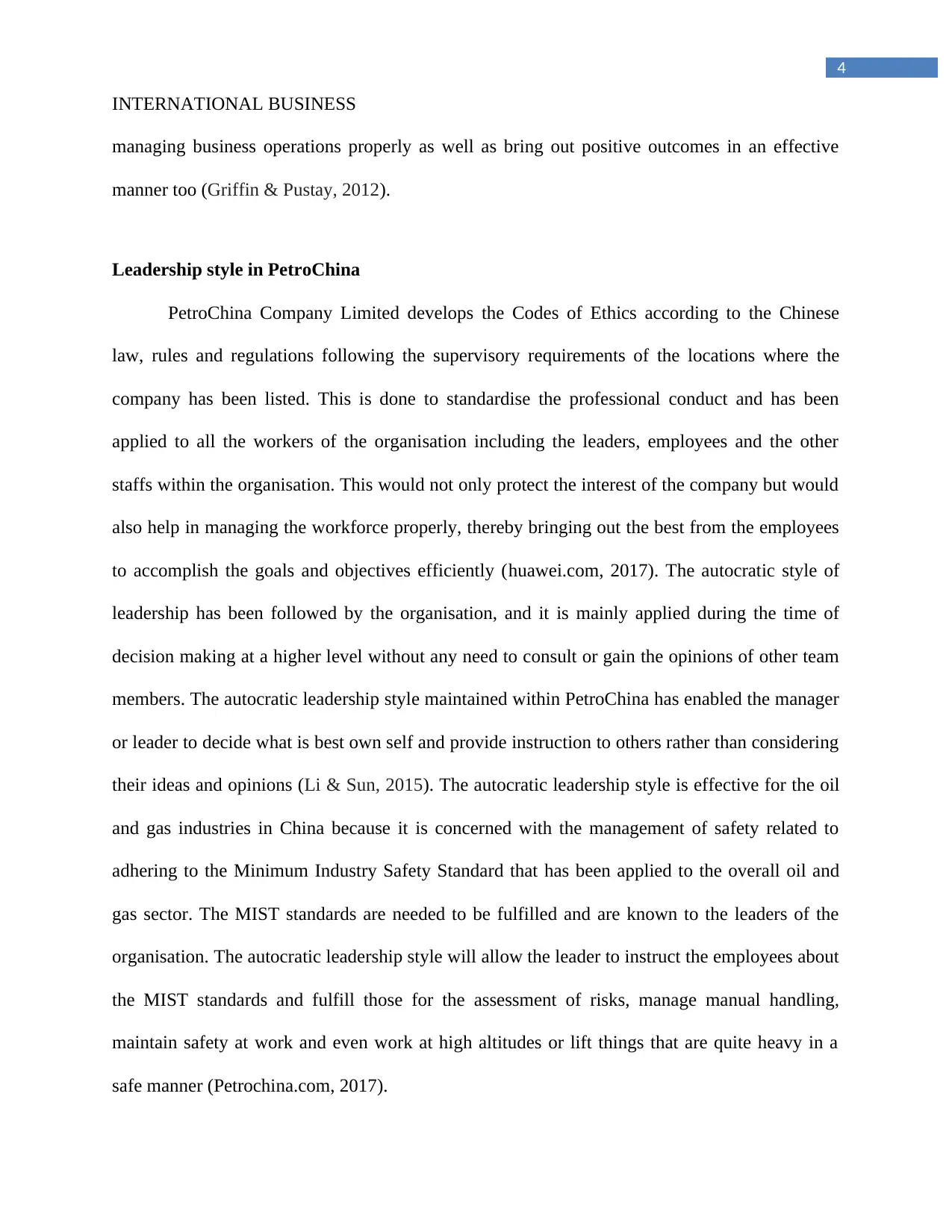
4
INTERNATIONAL BUSINESS
managing business operations properly as well as bring out positive outcomes in an effective
manner too (Griffin & Pustay, 2012).
Leadership style in PetroChina
PetroChina Company Limited develops the Codes of Ethics according to the Chinese
law, rules and regulations following the supervisory requirements of the locations where the
company has been listed. This is done to standardise the professional conduct and has been
applied to all the workers of the organisation including the leaders, employees and the other
staffs within the organisation. This would not only protect the interest of the company but would
also help in managing the workforce properly, thereby bringing out the best from the employees
to accomplish the goals and objectives efficiently (huawei.com, 2017). The autocratic style of
leadership has been followed by the organisation, and it is mainly applied during the time of
decision making at a higher level without any need to consult or gain the opinions of other team
members. The autocratic leadership style maintained within PetroChina has enabled the manager
or leader to decide what is best own self and provide instruction to others rather than considering
their ideas and opinions (Li & Sun, 2015). The autocratic leadership style is effective for the oil
and gas industries in China because it is concerned with the management of safety related to
adhering to the Minimum Industry Safety Standard that has been applied to the overall oil and
gas sector. The MIST standards are needed to be fulfilled and are known to the leaders of the
organisation. The autocratic leadership style will allow the leader to instruct the employees about
the MIST standards and fulfill those for the assessment of risks, manage manual handling,
maintain safety at work and even work at high altitudes or lift things that are quite heavy in a
safe manner (Petrochina.com, 2017).
INTERNATIONAL BUSINESS
managing business operations properly as well as bring out positive outcomes in an effective
manner too (Griffin & Pustay, 2012).
Leadership style in PetroChina
PetroChina Company Limited develops the Codes of Ethics according to the Chinese
law, rules and regulations following the supervisory requirements of the locations where the
company has been listed. This is done to standardise the professional conduct and has been
applied to all the workers of the organisation including the leaders, employees and the other
staffs within the organisation. This would not only protect the interest of the company but would
also help in managing the workforce properly, thereby bringing out the best from the employees
to accomplish the goals and objectives efficiently (huawei.com, 2017). The autocratic style of
leadership has been followed by the organisation, and it is mainly applied during the time of
decision making at a higher level without any need to consult or gain the opinions of other team
members. The autocratic leadership style maintained within PetroChina has enabled the manager
or leader to decide what is best own self and provide instruction to others rather than considering
their ideas and opinions (Li & Sun, 2015). The autocratic leadership style is effective for the oil
and gas industries in China because it is concerned with the management of safety related to
adhering to the Minimum Industry Safety Standard that has been applied to the overall oil and
gas sector. The MIST standards are needed to be fulfilled and are known to the leaders of the
organisation. The autocratic leadership style will allow the leader to instruct the employees about
the MIST standards and fulfill those for the assessment of risks, manage manual handling,
maintain safety at work and even work at high altitudes or lift things that are quite heavy in a
safe manner (Petrochina.com, 2017).
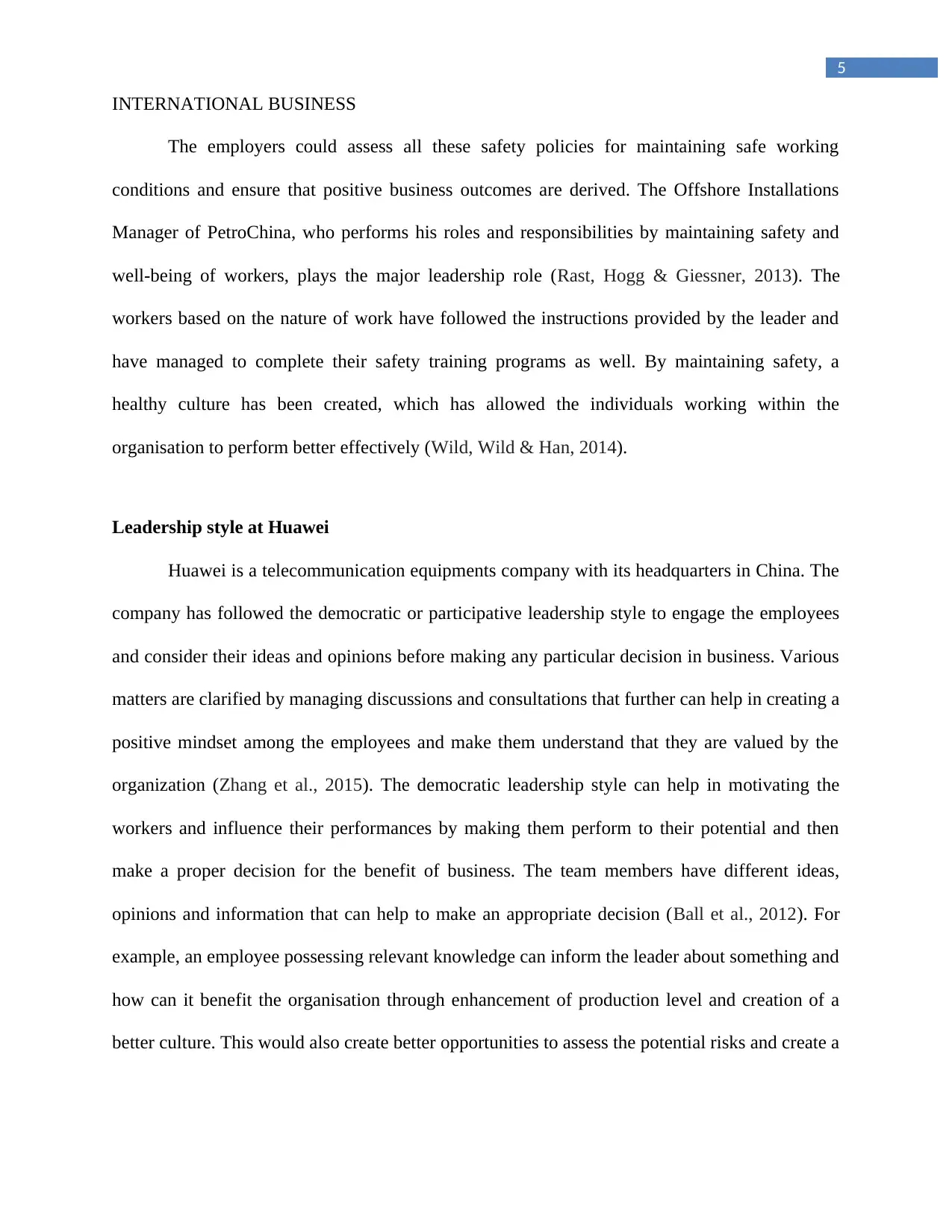
5
INTERNATIONAL BUSINESS
The employers could assess all these safety policies for maintaining safe working
conditions and ensure that positive business outcomes are derived. The Offshore Installations
Manager of PetroChina, who performs his roles and responsibilities by maintaining safety and
well-being of workers, plays the major leadership role (Rast, Hogg & Giessner, 2013). The
workers based on the nature of work have followed the instructions provided by the leader and
have managed to complete their safety training programs as well. By maintaining safety, a
healthy culture has been created, which has allowed the individuals working within the
organisation to perform better effectively (Wild, Wild & Han, 2014).
Leadership style at Huawei
Huawei is a telecommunication equipments company with its headquarters in China. The
company has followed the democratic or participative leadership style to engage the employees
and consider their ideas and opinions before making any particular decision in business. Various
matters are clarified by managing discussions and consultations that further can help in creating a
positive mindset among the employees and make them understand that they are valued by the
organization (Zhang et al., 2015). The democratic leadership style can help in motivating the
workers and influence their performances by making them perform to their potential and then
make a proper decision for the benefit of business. The team members have different ideas,
opinions and information that can help to make an appropriate decision (Ball et al., 2012). For
example, an employee possessing relevant knowledge can inform the leader about something and
how can it benefit the organisation through enhancement of production level and creation of a
better culture. This would also create better opportunities to assess the potential risks and create a
INTERNATIONAL BUSINESS
The employers could assess all these safety policies for maintaining safe working
conditions and ensure that positive business outcomes are derived. The Offshore Installations
Manager of PetroChina, who performs his roles and responsibilities by maintaining safety and
well-being of workers, plays the major leadership role (Rast, Hogg & Giessner, 2013). The
workers based on the nature of work have followed the instructions provided by the leader and
have managed to complete their safety training programs as well. By maintaining safety, a
healthy culture has been created, which has allowed the individuals working within the
organisation to perform better effectively (Wild, Wild & Han, 2014).
Leadership style at Huawei
Huawei is a telecommunication equipments company with its headquarters in China. The
company has followed the democratic or participative leadership style to engage the employees
and consider their ideas and opinions before making any particular decision in business. Various
matters are clarified by managing discussions and consultations that further can help in creating a
positive mindset among the employees and make them understand that they are valued by the
organization (Zhang et al., 2015). The democratic leadership style can help in motivating the
workers and influence their performances by making them perform to their potential and then
make a proper decision for the benefit of business. The team members have different ideas,
opinions and information that can help to make an appropriate decision (Ball et al., 2012). For
example, an employee possessing relevant knowledge can inform the leader about something and
how can it benefit the organisation through enhancement of production level and creation of a
better culture. This would also create better opportunities to assess the potential risks and create a
⊘ This is a preview!⊘
Do you want full access?
Subscribe today to unlock all pages.

Trusted by 1+ million students worldwide
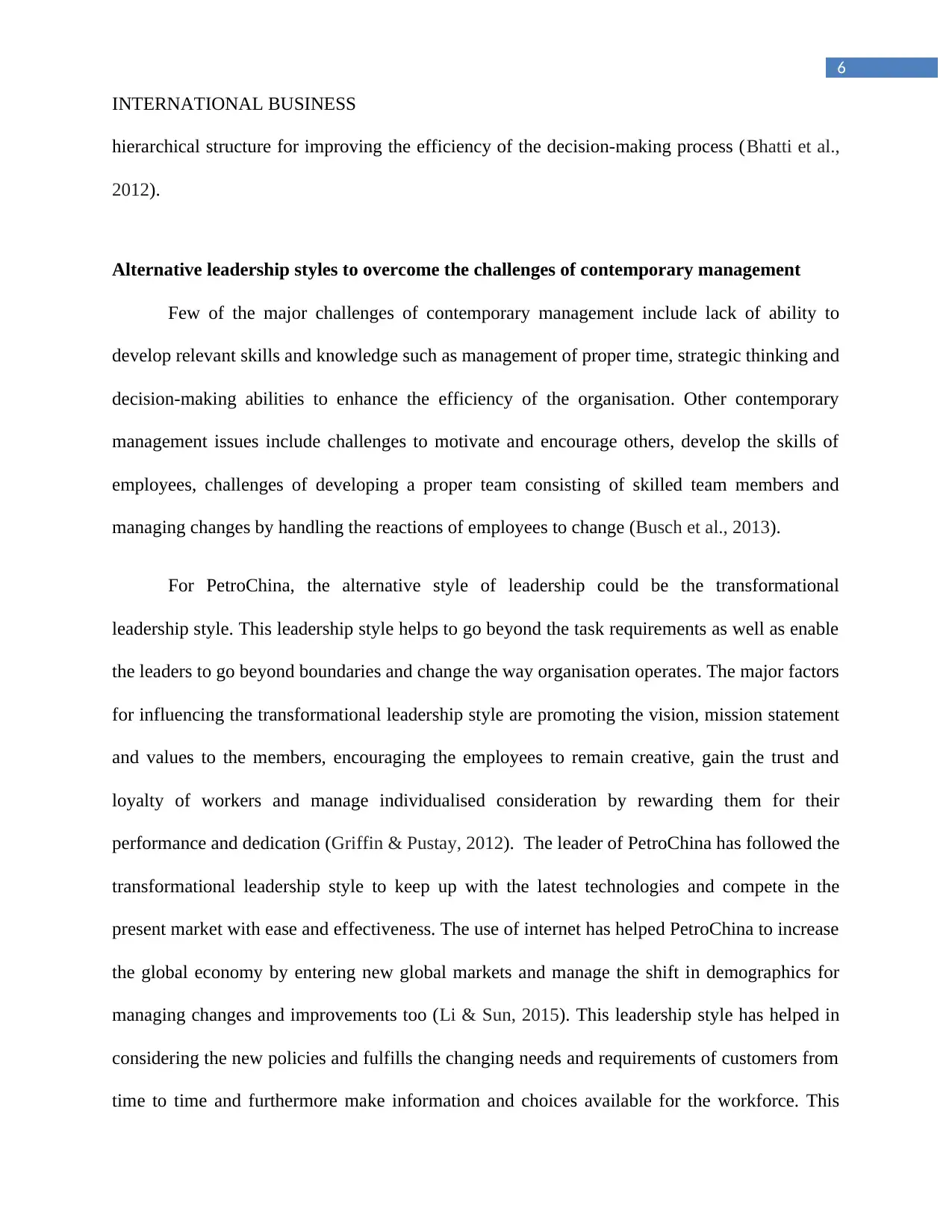
6
INTERNATIONAL BUSINESS
hierarchical structure for improving the efficiency of the decision-making process (Bhatti et al.,
2012).
Alternative leadership styles to overcome the challenges of contemporary management
Few of the major challenges of contemporary management include lack of ability to
develop relevant skills and knowledge such as management of proper time, strategic thinking and
decision-making abilities to enhance the efficiency of the organisation. Other contemporary
management issues include challenges to motivate and encourage others, develop the skills of
employees, challenges of developing a proper team consisting of skilled team members and
managing changes by handling the reactions of employees to change (Busch et al., 2013).
For PetroChina, the alternative style of leadership could be the transformational
leadership style. This leadership style helps to go beyond the task requirements as well as enable
the leaders to go beyond boundaries and change the way organisation operates. The major factors
for influencing the transformational leadership style are promoting the vision, mission statement
and values to the members, encouraging the employees to remain creative, gain the trust and
loyalty of workers and manage individualised consideration by rewarding them for their
performance and dedication (Griffin & Pustay, 2012). The leader of PetroChina has followed the
transformational leadership style to keep up with the latest technologies and compete in the
present market with ease and effectiveness. The use of internet has helped PetroChina to increase
the global economy by entering new global markets and manage the shift in demographics for
managing changes and improvements too (Li & Sun, 2015). This leadership style has helped in
considering the new policies and fulfills the changing needs and requirements of customers from
time to time and furthermore make information and choices available for the workforce. This
INTERNATIONAL BUSINESS
hierarchical structure for improving the efficiency of the decision-making process (Bhatti et al.,
2012).
Alternative leadership styles to overcome the challenges of contemporary management
Few of the major challenges of contemporary management include lack of ability to
develop relevant skills and knowledge such as management of proper time, strategic thinking and
decision-making abilities to enhance the efficiency of the organisation. Other contemporary
management issues include challenges to motivate and encourage others, develop the skills of
employees, challenges of developing a proper team consisting of skilled team members and
managing changes by handling the reactions of employees to change (Busch et al., 2013).
For PetroChina, the alternative style of leadership could be the transformational
leadership style. This leadership style helps to go beyond the task requirements as well as enable
the leaders to go beyond boundaries and change the way organisation operates. The major factors
for influencing the transformational leadership style are promoting the vision, mission statement
and values to the members, encouraging the employees to remain creative, gain the trust and
loyalty of workers and manage individualised consideration by rewarding them for their
performance and dedication (Griffin & Pustay, 2012). The leader of PetroChina has followed the
transformational leadership style to keep up with the latest technologies and compete in the
present market with ease and effectiveness. The use of internet has helped PetroChina to increase
the global economy by entering new global markets and manage the shift in demographics for
managing changes and improvements too (Li & Sun, 2015). This leadership style has helped in
considering the new policies and fulfills the changing needs and requirements of customers from
time to time and furthermore make information and choices available for the workforce. This
Paraphrase This Document
Need a fresh take? Get an instant paraphrase of this document with our AI Paraphraser
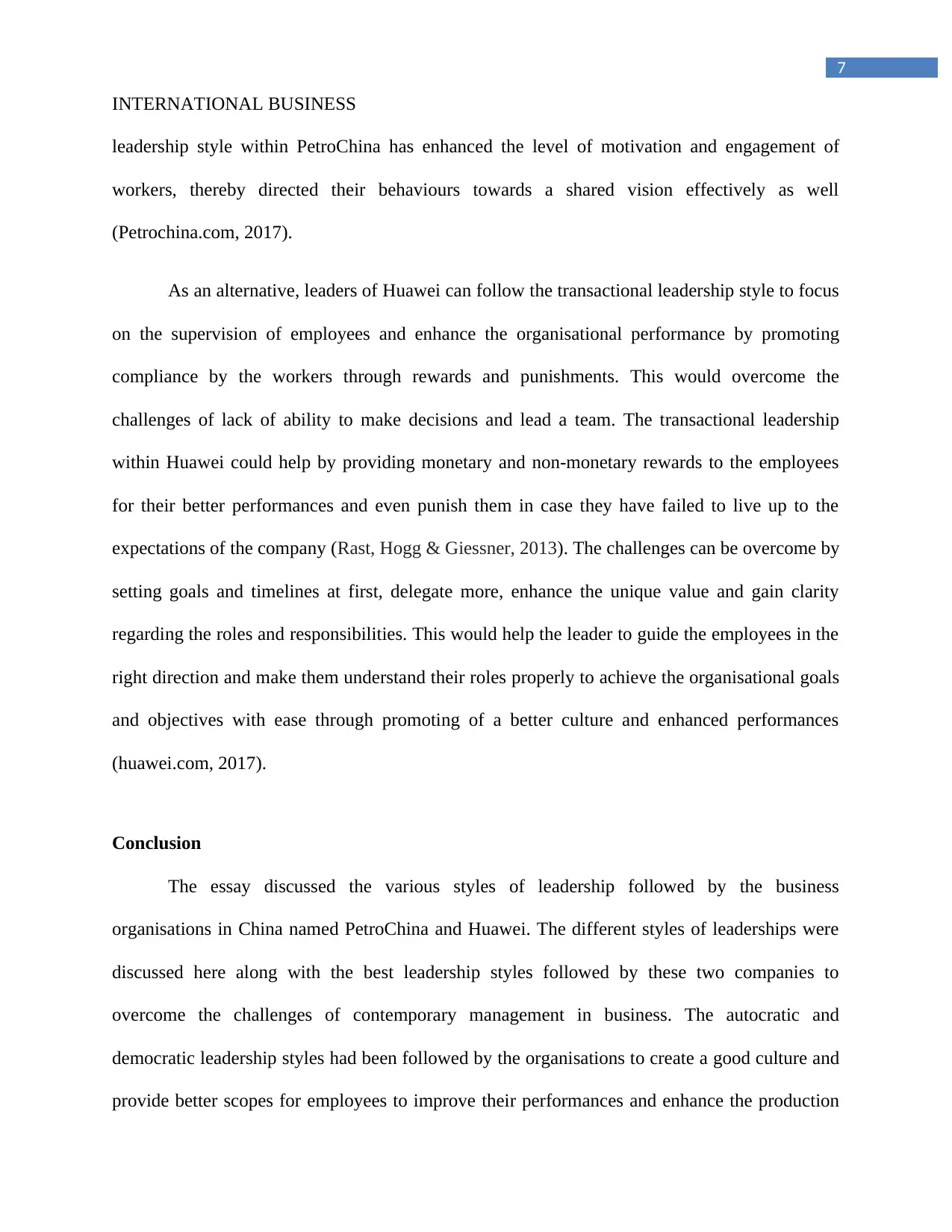
7
INTERNATIONAL BUSINESS
leadership style within PetroChina has enhanced the level of motivation and engagement of
workers, thereby directed their behaviours towards a shared vision effectively as well
(Petrochina.com, 2017).
As an alternative, leaders of Huawei can follow the transactional leadership style to focus
on the supervision of employees and enhance the organisational performance by promoting
compliance by the workers through rewards and punishments. This would overcome the
challenges of lack of ability to make decisions and lead a team. The transactional leadership
within Huawei could help by providing monetary and non-monetary rewards to the employees
for their better performances and even punish them in case they have failed to live up to the
expectations of the company (Rast, Hogg & Giessner, 2013). The challenges can be overcome by
setting goals and timelines at first, delegate more, enhance the unique value and gain clarity
regarding the roles and responsibilities. This would help the leader to guide the employees in the
right direction and make them understand their roles properly to achieve the organisational goals
and objectives with ease through promoting of a better culture and enhanced performances
(huawei.com, 2017).
Conclusion
The essay discussed the various styles of leadership followed by the business
organisations in China named PetroChina and Huawei. The different styles of leaderships were
discussed here along with the best leadership styles followed by these two companies to
overcome the challenges of contemporary management in business. The autocratic and
democratic leadership styles had been followed by the organisations to create a good culture and
provide better scopes for employees to improve their performances and enhance the production
INTERNATIONAL BUSINESS
leadership style within PetroChina has enhanced the level of motivation and engagement of
workers, thereby directed their behaviours towards a shared vision effectively as well
(Petrochina.com, 2017).
As an alternative, leaders of Huawei can follow the transactional leadership style to focus
on the supervision of employees and enhance the organisational performance by promoting
compliance by the workers through rewards and punishments. This would overcome the
challenges of lack of ability to make decisions and lead a team. The transactional leadership
within Huawei could help by providing monetary and non-monetary rewards to the employees
for their better performances and even punish them in case they have failed to live up to the
expectations of the company (Rast, Hogg & Giessner, 2013). The challenges can be overcome by
setting goals and timelines at first, delegate more, enhance the unique value and gain clarity
regarding the roles and responsibilities. This would help the leader to guide the employees in the
right direction and make them understand their roles properly to achieve the organisational goals
and objectives with ease through promoting of a better culture and enhanced performances
(huawei.com, 2017).
Conclusion
The essay discussed the various styles of leadership followed by the business
organisations in China named PetroChina and Huawei. The different styles of leaderships were
discussed here along with the best leadership styles followed by these two companies to
overcome the challenges of contemporary management in business. The autocratic and
democratic leadership styles had been followed by the organisations to create a good culture and
provide better scopes for employees to improve their performances and enhance the production
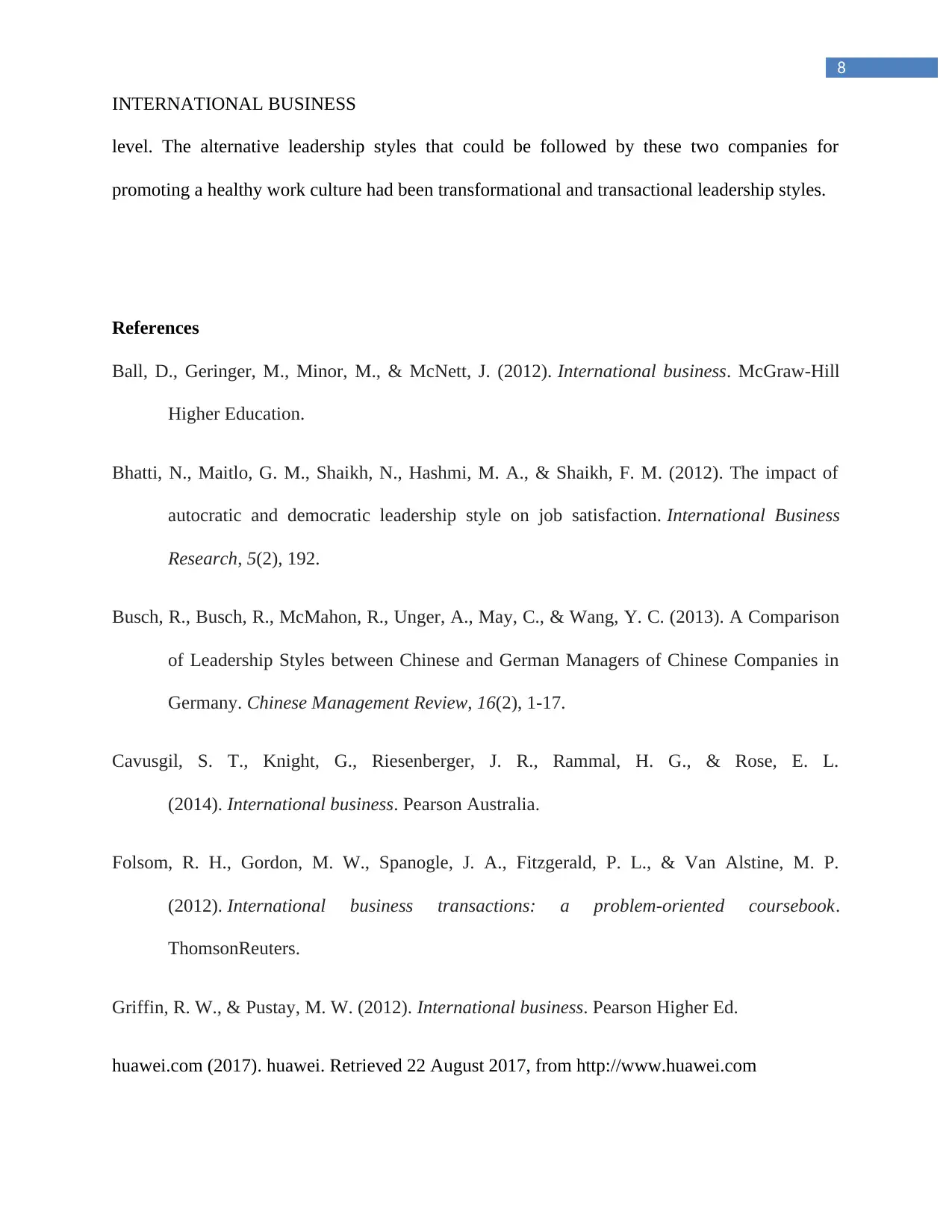
8
INTERNATIONAL BUSINESS
level. The alternative leadership styles that could be followed by these two companies for
promoting a healthy work culture had been transformational and transactional leadership styles.
References
Ball, D., Geringer, M., Minor, M., & McNett, J. (2012). International business. McGraw-Hill
Higher Education.
Bhatti, N., Maitlo, G. M., Shaikh, N., Hashmi, M. A., & Shaikh, F. M. (2012). The impact of
autocratic and democratic leadership style on job satisfaction. International Business
Research, 5(2), 192.
Busch, R., Busch, R., McMahon, R., Unger, A., May, C., & Wang, Y. C. (2013). A Comparison
of Leadership Styles between Chinese and German Managers of Chinese Companies in
Germany. Chinese Management Review, 16(2), 1-17.
Cavusgil, S. T., Knight, G., Riesenberger, J. R., Rammal, H. G., & Rose, E. L.
(2014). International business. Pearson Australia.
Folsom, R. H., Gordon, M. W., Spanogle, J. A., Fitzgerald, P. L., & Van Alstine, M. P.
(2012). International business transactions: a problem-oriented coursebook.
ThomsonReuters.
Griffin, R. W., & Pustay, M. W. (2012). International business. Pearson Higher Ed.
huawei.com (2017). huawei. Retrieved 22 August 2017, from http://www.huawei.com
INTERNATIONAL BUSINESS
level. The alternative leadership styles that could be followed by these two companies for
promoting a healthy work culture had been transformational and transactional leadership styles.
References
Ball, D., Geringer, M., Minor, M., & McNett, J. (2012). International business. McGraw-Hill
Higher Education.
Bhatti, N., Maitlo, G. M., Shaikh, N., Hashmi, M. A., & Shaikh, F. M. (2012). The impact of
autocratic and democratic leadership style on job satisfaction. International Business
Research, 5(2), 192.
Busch, R., Busch, R., McMahon, R., Unger, A., May, C., & Wang, Y. C. (2013). A Comparison
of Leadership Styles between Chinese and German Managers of Chinese Companies in
Germany. Chinese Management Review, 16(2), 1-17.
Cavusgil, S. T., Knight, G., Riesenberger, J. R., Rammal, H. G., & Rose, E. L.
(2014). International business. Pearson Australia.
Folsom, R. H., Gordon, M. W., Spanogle, J. A., Fitzgerald, P. L., & Van Alstine, M. P.
(2012). International business transactions: a problem-oriented coursebook.
ThomsonReuters.
Griffin, R. W., & Pustay, M. W. (2012). International business. Pearson Higher Ed.
huawei.com (2017). huawei. Retrieved 22 August 2017, from http://www.huawei.com
⊘ This is a preview!⊘
Do you want full access?
Subscribe today to unlock all pages.

Trusted by 1+ million students worldwide
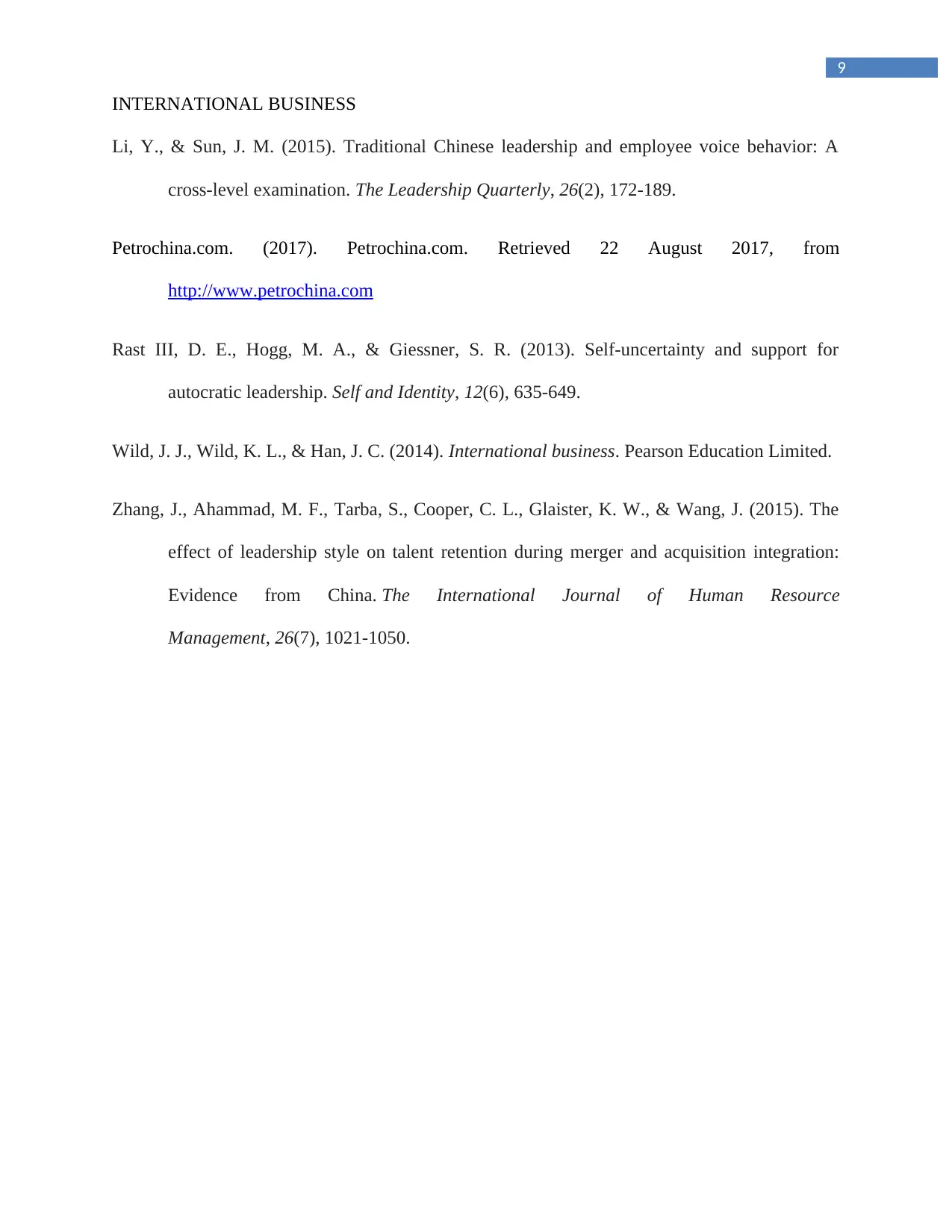
9
INTERNATIONAL BUSINESS
Li, Y., & Sun, J. M. (2015). Traditional Chinese leadership and employee voice behavior: A
cross-level examination. The Leadership Quarterly, 26(2), 172-189.
Petrochina.com. (2017). Petrochina.com. Retrieved 22 August 2017, from
http://www.petrochina.com
Rast III, D. E., Hogg, M. A., & Giessner, S. R. (2013). Self-uncertainty and support for
autocratic leadership. Self and Identity, 12(6), 635-649.
Wild, J. J., Wild, K. L., & Han, J. C. (2014). International business. Pearson Education Limited.
Zhang, J., Ahammad, M. F., Tarba, S., Cooper, C. L., Glaister, K. W., & Wang, J. (2015). The
effect of leadership style on talent retention during merger and acquisition integration:
Evidence from China. The International Journal of Human Resource
Management, 26(7), 1021-1050.
INTERNATIONAL BUSINESS
Li, Y., & Sun, J. M. (2015). Traditional Chinese leadership and employee voice behavior: A
cross-level examination. The Leadership Quarterly, 26(2), 172-189.
Petrochina.com. (2017). Petrochina.com. Retrieved 22 August 2017, from
http://www.petrochina.com
Rast III, D. E., Hogg, M. A., & Giessner, S. R. (2013). Self-uncertainty and support for
autocratic leadership. Self and Identity, 12(6), 635-649.
Wild, J. J., Wild, K. L., & Han, J. C. (2014). International business. Pearson Education Limited.
Zhang, J., Ahammad, M. F., Tarba, S., Cooper, C. L., Glaister, K. W., & Wang, J. (2015). The
effect of leadership style on talent retention during merger and acquisition integration:
Evidence from China. The International Journal of Human Resource
Management, 26(7), 1021-1050.
1 out of 10
Related Documents
Your All-in-One AI-Powered Toolkit for Academic Success.
+13062052269
info@desklib.com
Available 24*7 on WhatsApp / Email
![[object Object]](/_next/static/media/star-bottom.7253800d.svg)
Unlock your academic potential
Copyright © 2020–2025 A2Z Services. All Rights Reserved. Developed and managed by ZUCOL.





